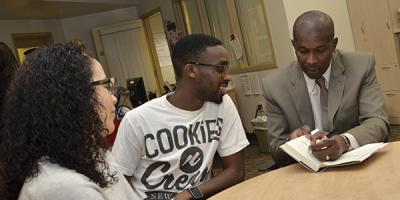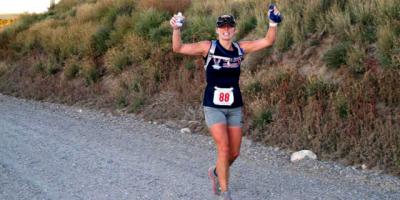In this Upstate classroom, se habla español

María-Lourdes Fallace (center) talks with students during a doctor-patient exercise in the Medical Spanish course she teaches at Upstate. Students (from left) are Laura Szczesniak, Daniel Farrell, Dulce Barrios and Ryan Nightingale. (PHOTO BY WILLIAM MUELLER)
Si nadie entiende mi lengua en el hospital, ¿cómo van a entender mis problemas médicos?
If you had trouble understanding that first sentence, you can probably sympathize with a Spanish speaker who might say it. It means, “If no one understands my language in the hospital, how are they going to understand my medical problems?”
Bridging that language gap is the goal of María-Lourdes Fallace, who has been teaching medical Spanish to future doctors and others at Upstate for more than a decade.
The elective classes range from basic to advanced and include students who never studied Spanish as well as native Spanish speakers who never learned medical terms.
As they learn the proper names for body parts, symptoms and diseases, the students also enlarge their conversational ability and their grasp of the cultural norms and attitudes they are likely to encounter among native Spanish speakers. Fallace, a native of Ecuador who has lived in Syracuse for several decades, enhances her teaching with insights into Latin American cultures.
For example, in a recent advanced class, students spoke in Spanish about diversity in the Hispanic world, including how different countries, regions and ethnic groups regard skin color.
Medical students Ryan Nightingale of Chatham and Daniel Farrell of Syracuse are taking the class to sharpen their Spanish. Both have spent time in Latin America and plan to do dengue virus research in Ecuador this summer.
Fellow student Dulce Barrios from Miami is a native of Cuba who grew up speaking Spanish. She says the class reinforces the importance of explaining things to patients and the need to show respect.
The classes also teach the importance of observation, notes Laura Szczesniak of Utica, another student, who adds that patients appreciate being greeted and spoken to in their own language.
Fallace began learning medical terms from her grandfather, a retired physician, when she was a child. She also works as a bilingual medical interpreter and was honored in 2015 by the state Assembly for leadership and advocacy among the region‘s Hispanic residents.
“I find both teaching the medical Spanish to the students as well as the interpreting so incredibly rewarding,” she says. “You are helping people where they need it most, I tell my students. The moment they greet the patients, culturally, they have already made the contact, and the patient thinks, ‘He cares for me.‘”
In the advanced class, the students work with cases taken from real life, play various roles and ask relevant questions, keeping an eye on their grammar all the while.
A recent class, for example, featured a visitor who played the role of a 54-year-old man with chest pain and other problems. The students, acting as various specialists, had to diagnose his problem, explain to him what they were doing and act professionally in the face of his distrust, lack of cooperation, and, for added realism, his hysterical wife (played with glee by Fallace).
The students learned that this patient likes to eat hamburguesas con queso (cheeseburgers) and cebolla frita (fried onions), that he has a 95 percent obstrucción (blockage) in an artery and that his mother had an ataque al corazón (heart attack) before she was 50.
They convinced him not to leave the hospital until they could perform more exámenes (tests), advised him to start eating food that was más saludable (healthier) and suggested that his diet was not totally the fault of his esposa (wife).
The 6 most popular languages
Spanish is just one of more than 100 languages that might be spoken by Upstate patients every year. The other most frequently used languages include Arabic, Nepali, Somali, Karen (from Southeast Asia) and sign language, according to Upstate‘s patient education and interpreter services department.
 This article appears in the summer 2016 issue of Upstate Health magazine.
This article appears in the summer 2016 issue of Upstate Health magazine. 


